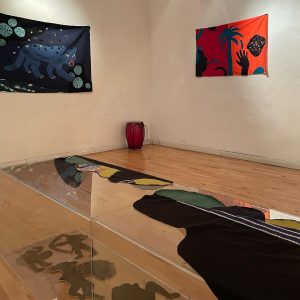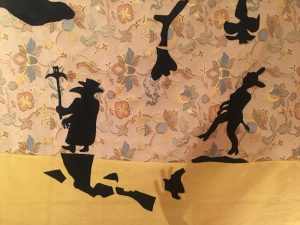Three years after her last solo show in Bologna, the Argentine illustrator Mariana Chiesa returns to the Portanova 12 gallery with the exhibition Furies, landscapes and figures, another intense project that presents the latest results of her expressive research. The artist, charismatic spokesperson for South American minorities tended to be ignored by the international media and passionate guardian of the popular culture of her country of origin, is distinguished by an immediate and versatile style, capable of fomenting revolt as well as materializing magical and primitive dreams.
The exhibition itinerary begins in the anteroom of the gallery with the engravings made in support of the Movimiento de Mujeres Indígenas por el Buen Vivir, a militant group of activists founded in 2013 by the Mapuche Moira Millan following a trip to Ushuaia, the southernmost city of the Argentina, which she embarked on to get to know firsthand what happened to indigenous women of various ethnic groups, unheard victims of terricidal violence. This neologism, coined to break the silence on the serious news and political events that take place in those latitudes, literally means “murder of the earth”, a definition that assimilates other forms of crime, such as femicide, ecocide and epistemicide. The goal of the movement is to obtain recognition from institutions and the media in order to then be able to take legal action against the Western companies responsible for the exploitation of those territories so precious for their natural resources and the consequent impoverishment of the indigenous inhabitants, whose habitat is daily plundered and withered. The members of the group, persecuted by the provincial governments as terrorists, do not define themselves as feminists but anti-patriarchal, to underline the political connotation of their resistance to a predatory system which, on the other hand, manages to find connivance in the men of the local communities, inclined to accept this dangerous transformation of their societies and to exchange resignation for negligible immediate economic advantages without giving weight to the irremediable mortgage on the future that this choice entails.
To the resistance and farsightedness of the activists of the movement Mariana Chiesa dedicates the engravings inspired by the Caminata Plurinacional, a procession which, after having crossed several Argentine provinces to give visibility to the issues of terricide, was replicated in other parts of the world, also arriving in Bologna, from where in May 2020 a long march started that led the participants to Altedo. On that occasion Mariana Chiesa had reprinted her drawings on “protest aprons” (one of which is present in the exhibition) which, worn by the demonstrators, summarized the feminine identity of the movement and offered themselves to view as iconic retables of complaint. In these plates, where the image is often combined with a text that expresses the urgency of the message, the rude language of the woodcut (also obtained through a violence, that of the gouge on the die to be engraved) communicates with primitive and resolute signs the ideals of a blunt political manifesto.
After the harshness of the engravings, which embody the testimony by amplifying its impact in the refusal of any aestheticizing mediation, the exhibition seems to change register at the entrance to the second room, introduced by a work on fabric born from the comparison with a composition by Bartolo Cattafi (1922 – 1979), which in July 2022 will be celebrated in a special project on the occasion of the centenary of his birth. The project includes a selection of twenty-two texts by the Sicilian poet, each of which will be the protagonist of a work by one of the artists of the gallery, illustrators and urban artists in balanced representation to reflect the combination on which the artistic directors Antonio Storelli and Massimo Cattafi orient their exhibition choices. In the small composition of silhouettes sewn on canvas by Mariana Chiesa the passionate rawness of the poet seems at first sight to dissolve in a calmed vision, even if the apparent calm of the shapes and colors is actually pregnant with atavistic tensions and totemic symbolism. In fact, the works on fabric of the artist, while evoking a soft dream world which is certainly less dramatic than the protest scenes outlined in the engravings, do not reflect an escape from current events, but only another aspect of the artist’s commitment in acting as a link between contemporary culture and the intellectual heritage permeated with the spirituality of its land of origin, under the banner of mutual enrichment.
In this sartorial artistic project, born as an evolution of the small fabric compositions of the “protest aprons”, Mariana Chiesa confronts increasingly larger formats, to the point of aspiring to the environmental dimension in the work in progress textile mural that concludes the exhibition as an experimental site-specific intervention open to public participation, invited to interact with a catalog of elements prepared by the artist that can be freely placed in an abstract landscape. The basic idea of these fabric assemblies derives from the Argentine folk tradition of the Almazuelas, textile works obtained by combining several scraps of different fabrics to create larger surfaces, such as bedspreads or other items of furniture for the home, so that the alternation of the different patterns form a grid of geometric designs. If the woodcuts appear dense with shadows and signs, here we see abstract fields of bright colors in which essential shapes float that concretize a hybrid spell between myth and fairy tale, a space of freedom in which the artist frees herself from the gravity of her demons translating them into beauty.
If the act of sewing conditions her stylistic code by inducing a more playful and pleasant expressive mode, while implying the concept of cutting as in engravings (with scissors instead of gouge), the imagery she draws on is anything but that disengaged. The characters, essential silhouettes that somehow recall the magical processions of shadows that enchant the gaze in William Kentridge’s animated films, are powerful totems and amulets put in place by the artist to reactivate the sacred concept of life that permeates the indigenous culture, whose survival could be the key to pacify the violent conflicts of our present and imagine a more sustainable existence overall. Also in this case the canvases by Mariana Chiesa seem to aspire to activism and could be read both as precious tapestries for a dream-lined domestic dimension and as magical banners of a procession which, evoking ancient supernatural entities, is able to mend the material reality with its spiritual counterpart.
Info:
Mariana Chiesa. Furie, paesaggi e figure
22/03/2022 – 23/04/2022
Portanova 12
Via Portanova 12 Bologna
For all the images: Mariana Chiesa. Furie, paesaggi e figure, installation view at Portanova 12, ph courtesy Portanova 12





Graduated in art history at DAMS in Bologna, city where she continued to live and work, she specialized in Siena with Enrico Crispolti. Curious and attentive to the becoming of the contemporary, she believes in the power of art to make life more interesting and she loves to explore its latest trends through dialogue with artists, curators and gallery owners. She considers writing a form of reasoning and analysis that reconstructs the connection between the artist’s creative path and the surrounding context.






NO COMMENT